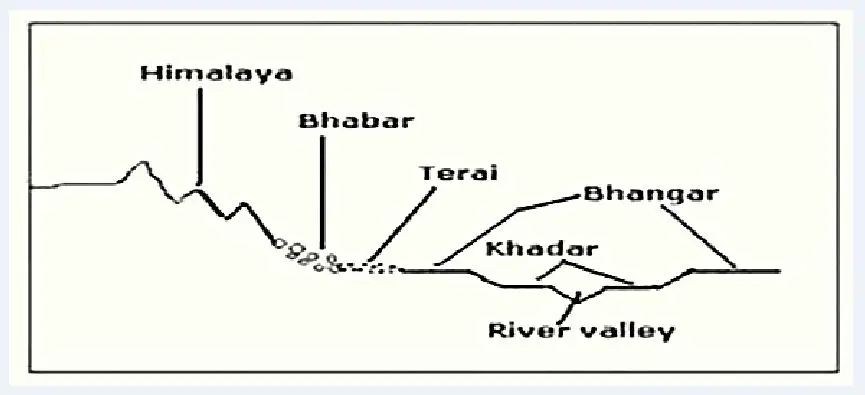
Difference between Bhabar, Terai, Bhangar and Khadar |UPSC – IAS
BHABAR:
Bhabar or Bhabhar is a region south of the Lower Himalayas and the Sivalik Hills in Uttarakhand state of India. It is the alluvial apron of sediments washed down from the Sivaliks along the northern edge of the Indo-Gangetic Plain.
- It lies along the foot of the Shiwaliks from the Indus to the Tista.
- It is 8 to 16 kms wide.
- It comprises of pebble- studded rocks in the shape of porus beds.
- Due to porosity of the rocks, the streams disappear and flow underground.
- This region is not much suitable for agriculture.
- It is made up of porous and rocky soils that get made of the debris washed down from the higher ranges.
- The climate here is subtropical and vegetation is Himalayan subtropical pine forests and Himalayan subtropical broadleaf forests.
- The Himalayan subtropical pine forests are dominated by Chir trees and Himalayan subtropical broadleaf forests are dominated by the sal tree (Shorea robusta).
TARAI:
Tarai, also spelled Terai, region of northern India and southern Nepal running parallel to the lower ranges of the Himalayas. A strip of undulating former marshland, it stretches from the Yamuna River in the west to the Brahmaputra River in the east.
- It lies to the south of the Bhabar and run parallel to it.
- It is 20 to 30 kms wide.
- It is composed of comparatively finer alluvium and is covered by forests.
- The underground streams of the Bhabar re-emerge on the surface and give birth to marshy area.
- Most parts of the Tarai area are reclaimed for agriculture.
- The speed of the Himalayan Rivers is slowed down in the Terai region and these rivers deposit fertile silt during the monsoons.
BHANGAR:
Bhangar soils are less fertile as they are above flood level whereas Khadar soils are more fertile as they are below flood level. Bhangar is full of kankers (lime nodules) while khadar soil is composed of fine silt and clay.
- It is the largest part of Northern plain.
- It is made up of alluvium.
- The soil in this region is not renewed frequently, it is old alluvial soil.
- It is not very fertile.
- It contains calcareous deposits locally known as ‘Kankar ‘.
- The Bhangar is the older alluvium along the river beds forming terraces higher than the floodplain.
- ‘The Barind plains’ in the deltaic region of Bengal and the ‘bhur formations’ in the middle Ganga and Yamuna doab are regional variations of Bhangar.
KHADAR:
New alluvium found on much of the Indo-Gangetic floodplain is called khadar and is extremely fertile and uniform in texture.
- It is not the largest part of Northern plain.
- It is made up of new alluvium and fine granules.
- The soil is frequently renewed due to frequent flooding.
- It does not contain calcareous deposits of calcium.
- Suitable for extensive cultivation
